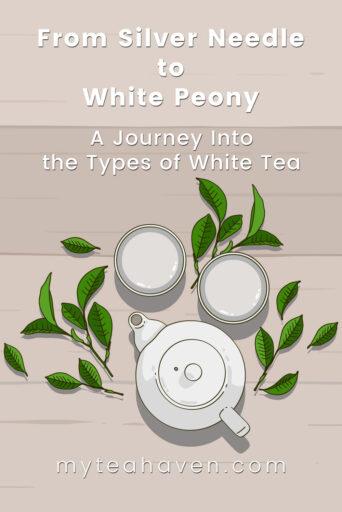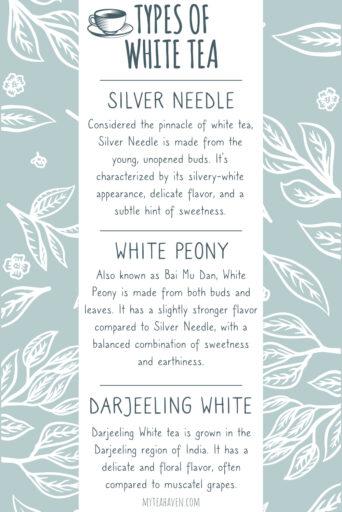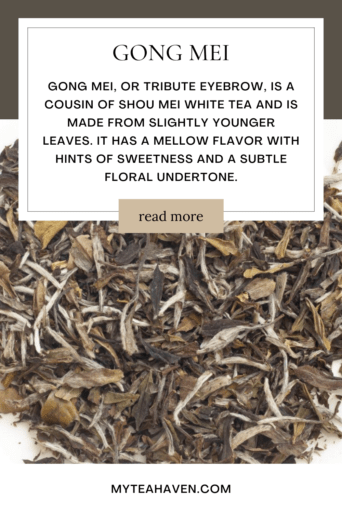From Silver Needle to White Peony: A Journey into the Types of White Tea
Types of White Tea
I obviously have a very deep appreciation for tea, and one of my favorite varieties to indulge in is white tea. With its delicate flavors, white tea has earned a special place in the hearts of tea enthusiasts worldwide. Today we’re going on a journey to explore the different types of white tea, so we can better understand what makes this variety so unique.
We are a participant in the Amazon Services LLC Associates Program, an affiliate advertising program designed to provide a means for us to earn fees by linking to Amazon.com and related sites. This post may contain affiliate links which means we may receive a commission, at no cost to you, for purchases made using our links. Please see my disclosure to learn more. Unless otherwise stated, all prices are in US$.
Introduction to White Tea
White tea is a type of tea that undergoes minimal processing, allowing the leaves to retain their natural flavor and appearance.
It’s made from the young leaves and buds of the Camellia sinensis plant, which are carefully harvested and dried. Unlike other tea types, white tea isn’t oxidized or rolled, resulting in a delicate and subtle brew.

Uncle Lee’s Organic White Tea
Sourced from the finest organic tea leaves grown and harvested in China, every refreshing white tea bag will satisfy your senses, sip after sip, any time of day.
Popular Varieties of White Tea
Like black, green, and oolong, white tea boasts a large variety of unique types. Let’s take a look:

Silver Needle
Considered the pinnacle of white tea, Silver Needle is made from the young, unopened buds.
It’s characterized by its silvery-white appearance, delicate flavor, and a subtle hint of sweetness.
White Peony
Also known as Bai Mu Dan, White Peony is made from both buds and leaves.
It has a slightly stronger flavor compared to Silver Needle, with a balanced combination of sweetness and earthiness.


Longevity Eyebrow (Shou Mei)
Longevity Eyebrow, or Shou Mei, is made from mature leaves. It offers a bolder flavor profile with notes of honey and a slightly earthy taste.
Fujian New Craft
Fujian New Craft white tea is a recent innovation in white tea production. It combines traditional white tea processing techniques with modern craftsmanship, resulting in a unique and flavorful tea.
Tribute Eyebrow (Gong Mei)
Tribute Eyebrow, or Gong Mei, is a cousin of Shou Mei and is made from slightly younger leaves. It has a mellow flavor with hints of sweetness and a subtle floral undertone.

White Puerh
White Puerh is a unique variety of white tea that undergoes a fermentation process similar to that of Puerh tea. It offers a distinct flavor profile with earthy and woody notes.

Darjeeling White
Darjeeling White tea is grown in the Darjeeling region of India.
It has a delicate and floral flavor, often compared to muscatel grapes.
Nepal White
Nepal White tea is grown in the high-altitude regions of Nepal. It offers a smooth and delicate flavor with floral and fruity undertones.
Brewing White Tea
To fully enjoy the flavors of white tea, proper brewing techniques are essential.
Start by using water at a temperature around 175°F (80°C), as boiling water can scorch the delicate leaves.
Steep the tea for 2 to 3 minutes, allowing the flavors to gently infuse. For optimal taste, use a tea-to-water ratio of 1 teaspoon of tea per 8 ounces of water.

Best Time to Enjoy White Tea
White tea is a versatile beverage that can be enjoyed at any time of the day. Its light and delicate flavors make it a perfect choice for a morning awakening or an afternoon pick-me-up. That being said, some tea lovers prefer to savor it in the evening due to its low caffeine content, which allows for a soothing and calming experience before bedtime.
Pairing White Tea With Food
When it comes to pairing white tea with food, it’s best to go for dishes that complement its delicate flavors. Light and delicate flavors such as fruits, salads, and seafood are excellent choices. The subtle sweetness of white tea can also harmonize well with pastries, light desserts, and white chocolate.
Storing White Tea Properly
To preserve the flavors and freshness of white tea, proper storage is crucial. Store white tea leaves in an airtight container, away from strong odors, heat, and moisture.
Avoid exposing the tea to sunlight, as it can degrade the delicate leaves. When stored correctly, white tea can maintain its quality for up to two years.
White Tea and Its Caffeine Content
White tea contains a moderate amount of caffeine, although significantly lower than black or green tea. The exact caffeine content may vary depending on the variety and brewing method. The average cup of white tea contains approximately 15-30 milligrams of caffeine, making it a suitable choice for those seeking a gentle energy boost without the jittery side effects.
White Tea vs. Green Tea: What’s the Difference?
While both white tea and green tea come from the same plant, they undergo different processing methods, resulting in distinct flavors and characteristics. White tea is minimally processed and has a delicate, nuanced flavor, while green tea is lightly oxidized, giving it a more grassy and vegetal taste. Additionally, white tea has a lower caffeine content compared to green tea.
White Tea vs. Black Tea: What’s the Difference?
Despite being derived from the same plant, white tea and black tea have significant differences. White tea undergoes minimal processing, allowing it to retain its natural flavors and delicate nuances.
On the other hand, black tea undergoes complete oxidation, resulting in a bold and robust flavor profile.
While white tea is known for its subtle and floral notes, black tea offers a more full-bodied and malty taste. The caffeine content also varies, with black tea generally having higher levels than white tea.
White Tea Myths Debunked
Let’s dispel a couple of common myths surrounding white tea:
- Myth: White tea is made from white tea leaves.
In reality, white tea leaves are not white. The name “white tea” refers to the silvery-white appearance of the buds and leaves, which are covered with fine white hairs.
- Myth: White tea is only consumed for its health benefits.
While white tea does offer numerous health benefits, it is also celebrated for its delicate flavors, aroma, and the overall experience it provides to tea enthusiasts.
White Tea and Sustainability
When choosing white tea, it’s worth considering organic and fair-trade options. Organic white tea is grown without the use of synthetic pesticides or fertilizers, minimizing harm to the environment and promoting the health of tea farmers.
Fair-trade white tea ensures that workers receive fair wages and work in safe conditions. By opting for sustainable white tea, we contribute to the well-being of both people and the planet.
Exploring White Tea Cultures and Traditions
White tea holds a significant place in Chinese tea culture, where it has been cherished for centuries. From the delicate preparation rituals to the art of serving and appreciating white tea, Chinese tea culture offers a rich tapestry of traditions surrounding this beloved beverage. Furthermore, white tea has also gained popularity in other countries, where unique customs and practices have emerged.
A Few Final Thoughts
White tea is a treasure in the world of teas, offering delicate flavors and a rich cultural heritage. Whether you’re a fan of the ethereal Silver Needle or the bolder Shou Mei, each variety of white tea provides a unique experience worth savoring.
Remember to brew your white tea with care, pair it with complementary flavors, and store it properly to enjoy its full potential.
So go ahead, take a sip, and let the world of white tea enchant your senses.


TRIPLE LEAF Tea White Peony
Delicate, fragrant, slightly sweet taste, an ancient Chinese tea once reserved for royalty.
Some Questions You Might Have
- Is white tea suitable for people with caffeine sensitivity?
White tea generally contains lower caffeine levels compared to other tea types, making it a more suitable choice for individuals with caffeine sensitivity. However, it’s always advisable to test your own tolerance and adjust consumption accordingly.
- Can I add milk or sweeteners to white tea?
White tea is best enjoyed on its own, without the addition of milk or sweeteners. These additions can overpower the delicate flavors of white tea and diminish its unique qualities.
- Can white tea help with stress relief?
While white tea doesn’t have specific stress-relieving properties, its gentle and soothing nature can provide a calming effect. Taking a moment to enjoy a cup of white tea can be a part of a mindful and relaxing routine.
- Are there any known allergies associated with white tea?
While white tea is generally well-tolerated, individuals with known allergies to tea leaves or plant-based compounds should exercise caution. It’s recommended to consult with a healthcare professional if you have concerns regarding potential allergies.
- Can white tea be enjoyed cold or iced?
Yes, white tea can be enjoyed cold or iced. Brewing white tea with lower water temperature and longer steeping times can result in a smooth and refreshing cold brew, perfect for hot summer days.






